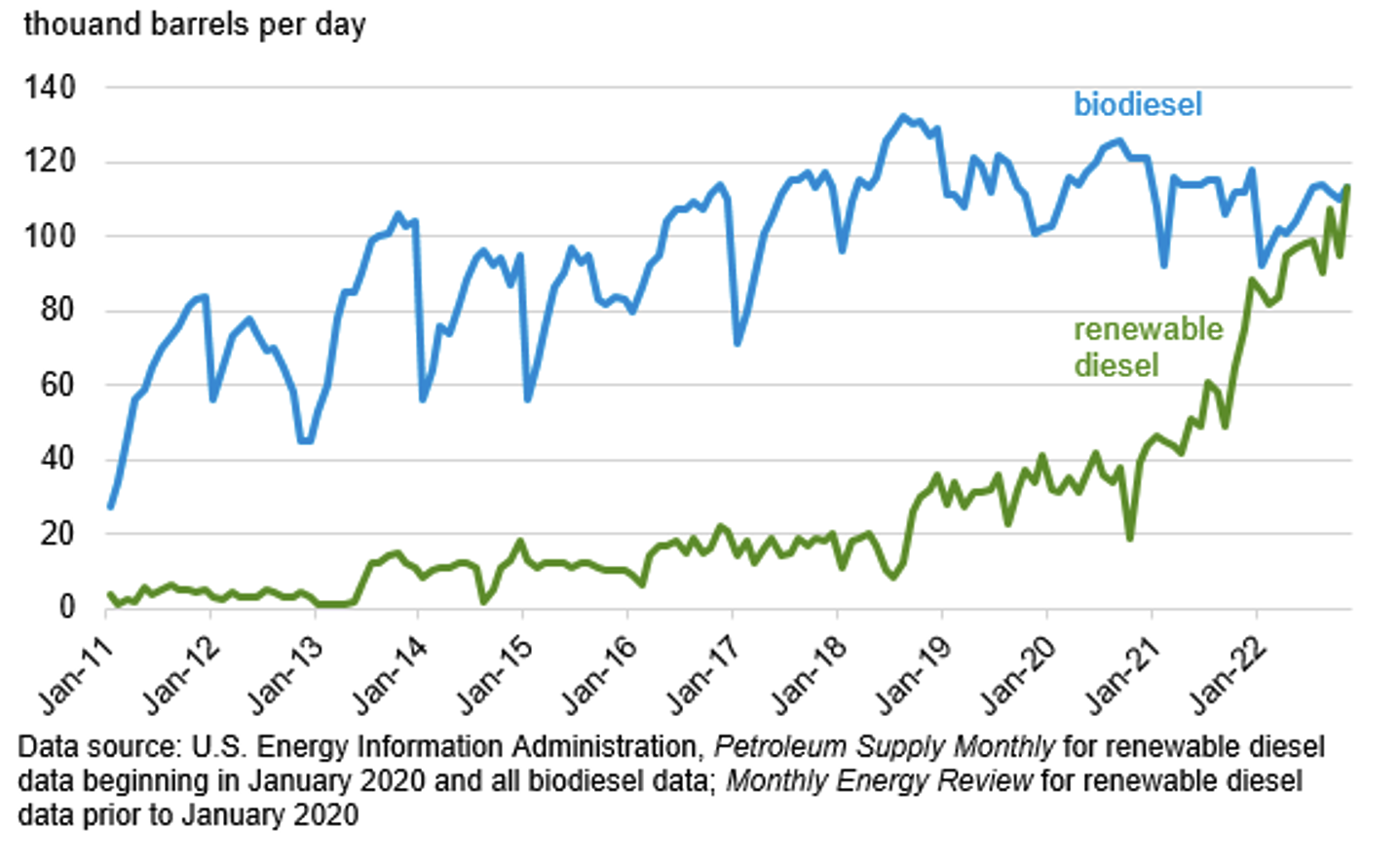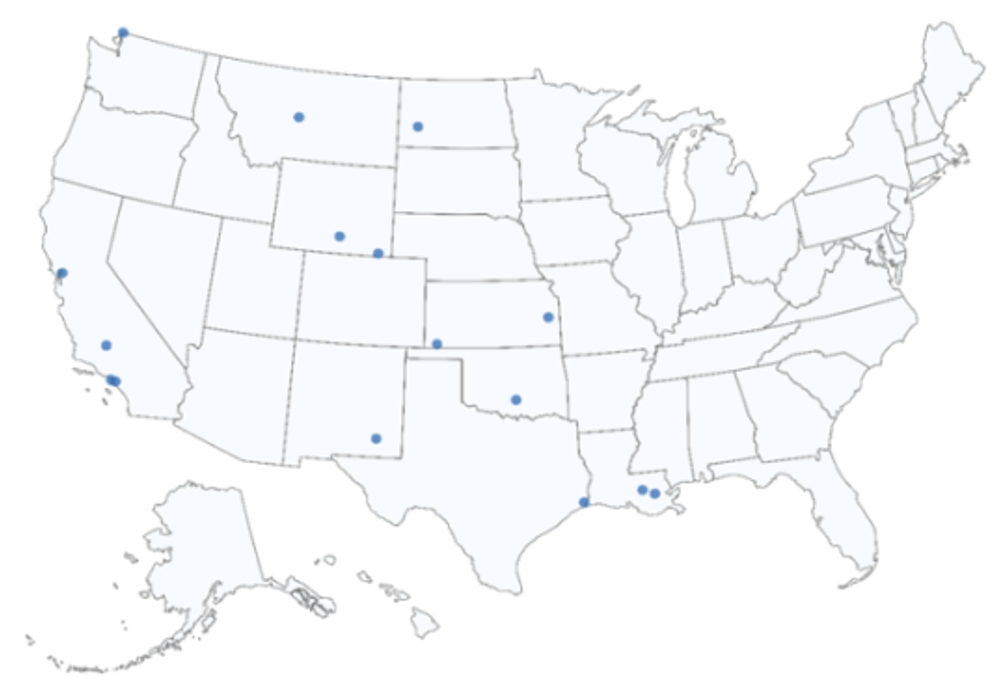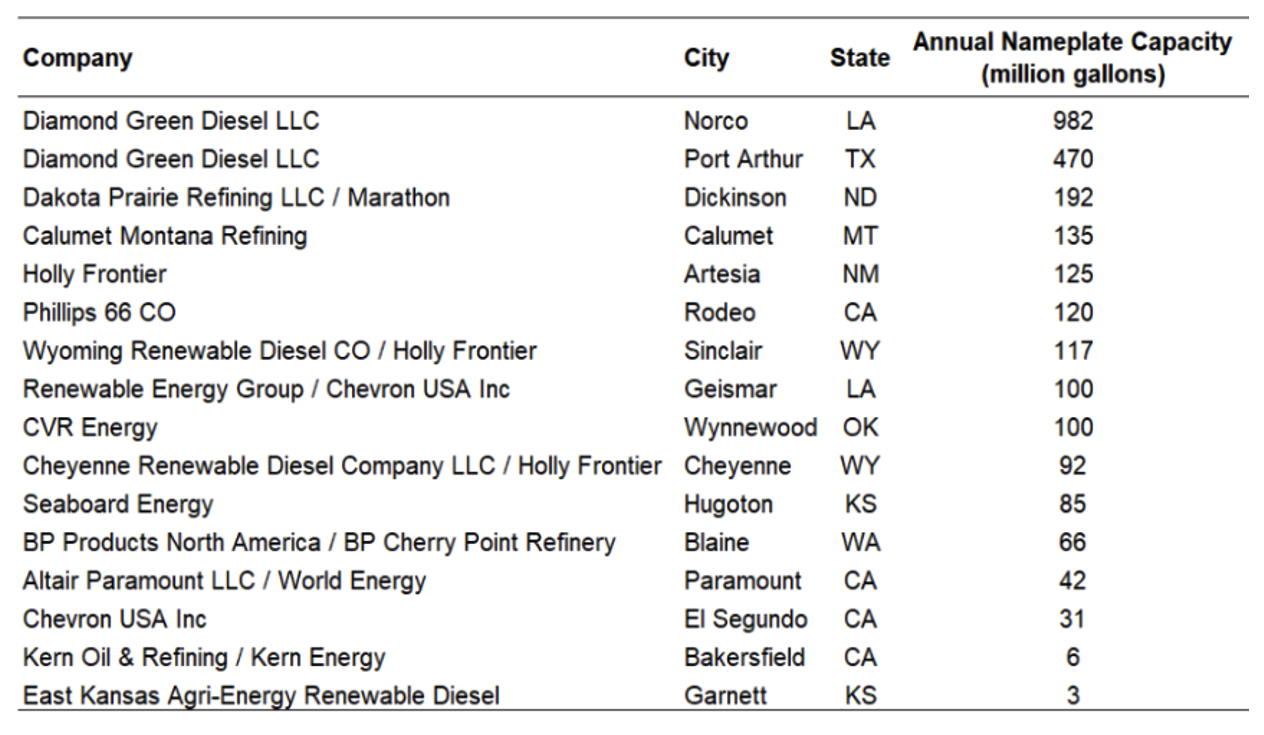Renewable Diesel 101
Link to article: https://stillwaterassociates.com/renewable-diesel-101/
June 12, 2023
By Jim Mladenik
Renewable diesel (RD) is the fastest-growing biofuel in America. It is also the fastest-growing way to reduce carbon emissions from transportation vehicles in California. This article is a basic introduction to RD that explains how it is used, why its use is growing so rapidly, and what to expect for its future growth.
What is RD, and how it is produced?
RD is chemically identical to the petroleum diesel fuel produced from crude oil. Petroleum diesel fuel is produced by treating a portion of crude oil with hydrogen in the presence of a catalyst (a process called hydrogenation or hydrotreating). This process reduces the sulfur content of the resulting fuel to below 15 parts per million, which subsequently reduces emissions of sulfur dioxide upon combustion of the diesel fuel. (hence the fuel name ultra-low sulfur diesel or ULSD)
RD is most commonly produced in a similar manner – via hydrogenation – but from renewable feedstocks such as used cooking oil (UCO), soybean oil, canola oil, and animal fats rather than crude oil. Other pathways exist to produce RD from a variety of feedstock materials, but these are more costly and have not yet proven to be commercially viable at scale. RD is considered a cleaner alternative to petroleum diesel fuel because the feedstocks used for its production come from the earth’s natural carbon cycle and therefore reduce net carbon emissions by 40 to 80% from diesel vehicles.
The equipment used to produce RD is similar to what is used in existing petroleum refineries, so many of the RD plants starting up are what’s called “brown field” sites – defunct petroleum refineries converted to RD production. There are also some “green field” RD production facilities – those built from the ground up. These can be more costly to develop but enable a custom design to meet future RD demand and can be located in strategically advantaged locations. In the production of RD, other renewable fuels such as liquified petroleum gas (LPG) which consists mostly of propane, naphtha (an unfinished gasoline), and jet fuel (also known as sustainable aviation fuel or SAF) are manufactured. These co-products are beginning to be used to reduce carbon emissions in various applications, but it is common to not fractionate (i.e., separate) the SAF from the RD because the RD has generally been more valuable than the SAF. However, several recent pieces of federal and state legislation have passed and are being considered that significantly increases the value of SAF[1], so its production is likely to increase significantly in the next few years.
RD is Not BD
The other primary alternative for decarbonizing the diesel fuel pool is biodiesel (BD). While BD is produced from the same feedstocks as RD, the technology utilized and therefore the fuel produced are quite different. BD is produced via a transesterification process which reacts vegetable oils or animal fats with an alcohol such as methanol or ethanol using a catalyst to form an ester compound that contains oxygen. This causes some compatibility issues for higher levels of BD because some existing infrastructure is made of materials that are not compatible with oxygen-containing chemicals. In addition, unlike RD, BD does not meet ASTM D975 specifications for petroleum diesel. (BD does meet the ASTM D6751 spec and is approved for blending with petroleum diesel.) The main disadvantages of biodiesel are its higher viscosity (which means that it may not flow very well in cold weather), higher nitrogen oxide (NOx) emissions, lower engine speed and power, potential injector coking, engine compatibility, and higher engine wear. Like RD, it is also much more expensive to produce than petroleum diesel, but the array of government policies that support RD also add significant value to BD.
Bottom line: RD is a “drop-in” fuel which is fully compatible with existing engines and infrastructure. Unlike BD, RD can be used without blending with petroleum diesel. This gives RD greater flexibility to fully displace diesel by blending to any level. Additionally, RD achieves greater GHG reductions than BD; namely, RD has lower NOx emissions. These advantages have led to tremendous growth in RD production over the past eight years as BD production has declined (as shown in the figure below.
U.S. Biodiesel and Renewable Diesel Production (Jan 2011-Nov 2022)

So, why is RD use growing so rapidly?
RD use is increasing dramatically for a variety of reasons:
- It is compatible with all existing diesel engines and fuel infrastructure at up to 100% blends.
- Government policies such as the Renewable Fuel Standard (RFS), biomass-based diesel blender’s tax credit (BTC), state Low Carbon Fuel (LCF) programs, and Cap-and-Trade (C&T) programs create economic incentives to produce RD and displace diesel.
- It has very good fuel quality – very low sulfur content and high cetane number (a measure of diesel fuel combustion quality).
- Corporations are increasing sustainability initiatives to reduce carbon emissions profiles.
- RD produced domestically aligns with energy independence goals which are central to federal programs such as the RFS and the Inflation Reduction Act of 2022.
- Ongoing improvements in RD production technologies are lowering production costs.
Where are the RD production facilities being built?
U.S. RD plant locations are shown in the figure and table below. The large Port Arthur facility, owned by Diamond Green which is joint venture between Valero Energy Corporation and Darling Ingredients, Inc., was one of the first of scale in the U.S. Its success led Diamond Green to invest in the even larger plant which has started up in Norco, Louisiana, and motivated a list of competitors to follow suit. The other early mover into RD was Neste, a company based in Finland which successfully piloted production at its Porvoo refinery which led to the construction of a large RD facility in Singapore more than a decade ago. They just completed an expansion there in April of this year. Currently, there are many other facilities under construction in the U.S. Canada, and Europe which has created a bit of concern over where the feedstocks for all of these facilities are going to come from.
Location of Renewable Diesel Production Plants in the U.S. (Dec. 2022)

Source: farmdoc Daily (with EIA and Render and Biodiesel Magazine data)
Renewable Diesel Plants and their Location in the U.S. (Dec 2022)

Source: farmdoc Daily (with EIA and Render and Biodiesel Magazine data)
What does future RD growth look like?
The question of how much RD production will increase in the next few years is greatly dependent on feedstock availability. The most valuable feedstocks are waste oils – UCO, tallow, yellow grease – because they have a lower carbon intensity (CI) value under state LCF programs and therefore generate more credits than crop-based oils such as soybean and canola oil. Increased U.S. vegetable oil production and collection of UCO, combined with a net increase in imports, will be required to fill new RD capacity built out in the years ahead, and most of the increased production will find its way into the markets that have LCF and other carbon-reduction programs such as California, Oregon, Washington, British Columbia and Canada.
(1) https://stillwaterassociates.com/saf-in-the-ira-era-how-do-the-incentives-stack-up/

